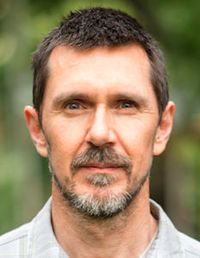In this seventh contribution to the INSURGE symposium, ‘Pathways to the Post-Carbon Economy’, Josh Floyd, Director of the Rescope Project, weighs in on how best to navigate the polarisation in the debate over renewable energy.
His most powerful insight, based on an in-depth grasp of complex systems sciences, is that polarisation itself is not the problem — the real issue is the extent to which we insist on being certain in our fixed positions on what we believe the future must hold.
But as he sets out so clearly, neither ardent proponents of renewable energy, nor its most rigorous critics, are necessarily on solid ground.
What’s needed, ultimately, is our embrace of what Floyd describes as “knowledge humility”: recognising the limits to our knowledge as we step into an emerging post-carbon world, the dynamics of which we have never experienced before.
Armed with the embrace of uncertainty, we find ourselves able to truly learn, no matter what perspective we might lean to.
The imperative of minimising further global temperature rise demands our strongest response.
The carbon budget that remains before emissions must cease for a chance of remaining below a 1.5 or even 2 degree Celsius increase is rapidly depleting.
The official line expresses this in terms of ‘net zero’, implying that some emissions can continue, as long as they’re offset by removal of the same amount from the atmosphere, for instance by forest growth. And, of course, there’s an ongoing hope that carbon capture and storage will allow some continued fossil fuel use.
But the prospects for such fixes depend on complex, dynamic interactions into the future between atmosphere, oceans and biosphere, and human social, political, economic and technological systems.
Efforts to quantify future potential for CO2 absorption by forests and reduction by CCS are subject to irreducible uncertainty and hence must be regarded as speculative. They may be politically attractive, but reliance on them cannot claim scientific legitimacy.
Axiom 1: If we take climate science seriously, then one way or another, any serious bid to minimise climate damage calls for complete decarbonisation of global energy supply within the next four decades. For rich, high-emitting nations, the timeline is much shorter.
Even if climate change response efforts were to founder politically, the imperative for energy transition would simply shift to a second front.
Axiom 2: Conventional petroleum production has barely increased in the past decade, as increasing territories peak and decline. New conventional resource finds have trailed production for decades. Globally, the ratio of capital expenditure to production rate increase expanded by an order of magnitude between the periods 1993–2005 and 2005–2013. And the IEA sees more than half of all energy investment in coming decades going to offset declining production from existing fields.
Shale oil has revealed even many highly-informed perspectives on peak oil dynamics to be far too simplistic. Even so, the more hyperbolic claims of a few years ago for a shale oil-led energy revolution are now proving equally flawed.
The industry is haemorrhaging under oil prices that, while far below the peak that drove the shale boom, are still at historically unremarkable levels on an inflation-adjusted basis.
Meanwhile, clouds hang over the oil majors’ balance sheets as debt soars, capital spending shrinks and revenues decline. The overall situation for oil foreshadows an emerging story for all fossil fuels — credible estimates (e.g. here and here) see a global production peak for all sources including coal and natural gas as decades away at most.
Expansion of currently commercial nuclear technology appears hamstrung by crippling capital costs and political barriers. Roll-out rates that would make a globally material difference on the climate front stretch the limits of plausibility.
Generation IV ‘intrinsically safe’ reactors that greatly reduce waste concerns and massively expand the scope of current fuel reserves look good on paper, but significant R&D remains, with the most advanced effort at pilot stage only.
Practical fusion power continues to be at best a theoretical possibility many decades in the future, despite many billions of dollars of past and ongoing investment.
This points towards futures in which powering human societies entirely — or as close as possible — with renewable sources appears to be our present best bet. In overall energy terms, it looks like wind and solar PV will need to do most of the heavy lifting. Questions of whether it’s feasible to power human societies in this way then naturally come to the fore.
There’s a rich irony here: it’s of course absolutely established that 100% renewably powered societies are feasible, by the simple fact of viable non-industrial human ways of life over the vast majority of our species’ existence. A great diversity of distinct human social forms demonstrates the adequacy of synchronous earth energy flows for successful functioning.
Axiom 3: While the longevity of societies varies greatly (and tends to favour smaller-scale and locally self-reliant communities over larger-scale and more complicated organisation), clearly humans are capable of getting along in ways that can persist for many generations with energy conversions restricted to biomass, sun, wind and water.
But renewable energy (RE) feasibility research overwhelmingly has a narrower focus. In essence it asks whether currently commercial and close-to-market RE conversion technologies can support industrial societies and economies functionally equivalent to those in place today.
Typically this involves computer modelling exercises that attempt to simulate future behaviour of energy supply systems (and in some cases, whole economies) with up to 100% of energy from sources including wind turbines, solar PV, concentrated solar thermal, hydro, biomass, geothermal and ocean energy.
Many studies consider current electricity supply only. Others consider all energy including transport fuels and industrial, commercial and household heat.
The models that engineers use to manage existing technological systems, to design new ones and to assess the feasibility of major infrastructure projects typically incorporate heuristics or ‘rules of thumb’, based on practical field experience with actual systems operating in the real world.
Prototyping and learning-by-doing are central to the conceptual understandings that engineers develop of how systems work, and the models they build to represent them. Experienced engineers often develop an intuitive grasp of the insight, attributed to Alfred Korzybski, that ‘the map is not the territory’.
This can help maintain healthy scepticism with regard to the truth claims that can be made on the basis of their models. As changes unfold in the real-world contexts to which models relate, engineers’ models need to adapt.
Axiom 4: Good models are informed by sound science, empirical evidence and best-available data. They are also products of their designers’ worldviews, of the questions they presently think are relevant to their interests (often reflecting disciplinary commitments), and of the particular perspectives that happen to be on hand for addressing these questions. They always reflect contingent decisions about what to include and exclude. They can never provide complete accounts of the situations they represent. As George Box put it, ‘All models are wrong; some models are useful.’
A characteristic of most RE feasibility studies is that, like the models engineers use, structural and data input assumptions reflect performance and costs observed under existing conditions. Current empirical understanding of RE technologies relates to contexts where these account for a relatively small proportion of overall energy supply, and where economies are predominantly dependent on fossil fuels (over 80% of global primary energy supply today is from fossil sources, a level that has been relatively constant for many decades).
Future performance and costs are typically taken to be independent of this current context — it’s assumed that changing the background physical economic context will not introduce feedback loops that alter the starting assumptions significantly.
But many essential industrial processes, and over 90% of all transport, depend on direct use of fossil fuels and their matching source-specific supply chains and end-use technologies. Present industrial and trade systems have evolved specifically in the context of these energy sources and their particular physical characteristics. The prospects for and implications of decarbonising these systems are fundamentally uncertain.
RE feasibility assessment models represent how researchers think future systems might work. They can be verified to make sure that they accurately reflect the researchers’ current conceptual understanding of how possible futures might unfold, but they must by definition be incomplete, and they can’t be validated against real world performance — because that real world does not (yet?) exist.
The scope, complexity and scale of the changes involved in reconfiguring today’s predominantly fossil-fuelled industrial economies to suit the characteristics of renewable energy flows precludes any possibility of rational analysis delivering certain knowledge today of what such future economies will look like and how they will work.
Insight: More and better abstract analysis can’t lead to convergence on an absolutely true account of future real-world behaviour. Model-generated knowledge can only ever reach absolute certainty with reference to the model itself, rather than the territory that the model seeks to represent. For the messy, complex socio-technical situations to which RE feasibility assessment relates, there is no independent basis for assessing whether the models themselves are sufficiently fit for purpose. Models tell us what might happen, if their assumptions hold in future real-world conditions.
It follows that any claims about the certainty of future energy system performance should be regarded as premature. Our present situation warrants a significant level of knowledge humility. We can’t know for sure how future energy systems will function, what they will cost, and the types of societies they will allow, but modelling efforts can provide indications of what is and isn’t possible if given sets of conditions prevail.
There are important benefits that come with greater knowledge humility. Acknowledging what we don’t know, as well as what we do, can support more flexible and adaptive ways of navigating transition pathways.
If we hold present knowledge more lightly, then we’ll be better prepared to make sense of what’s going on, change what we think we know, and respond accordingly when field conditions inevitably unfold in ways different to those initially anticipated. This also supports more resilient social and political commitment to the transition task, as it mitigates the disillusioned response that’s likely if things turn out differently to what was promised.
Perhaps more importantly though, by acknowledging the limits of our own models, we’re likely to be more open to hearing how others understand the situation, and learning from this.
We hear a lot about the polarised perspectives holding that current renewable technologies absolutely can or absolutely cannot provide the scope and scale of energy services currently provided by fossil fuels.
There’s a broad middle-ground though that tends to have a lower public profile. These are the many serious and highly-informed investigators who support the transition to renewable energy to whatever extent is possible, and who at the same time regard the nature of future energy systems — and often, the forms of economy and society that they enable — to be uncertain.
Many in this middle-ground share a commitment to thinking critically about the roles and prospects for RE conversion technologies. Thinking critically is not the same as being a ‘RE critic’, or ‘anti-RE’. It involves carefully considering the contexts for knowledge claims, including the confidence with which one can regard knowledge generated in a particular context as holding for others. This seems to be important for developing the knowledge humility that can support collaborative learning and action.
Insight: If there is one thing of which we can perhaps be very confident, it’s that a RE transition will test humanity’s collaboration capacities like never before. This is a situation that, in one way or another, will affect and involve every facet of society. We will inevitably need to work with those who, in the words of Adam Kahane, we ‘don’t agree with or trust or like.’ We’ll be greatly aided in this if we start by relinquishing the need to arrive at single answers to feasibility questions.
RE feasibility questions will ultimately be answered through the collective transition effort. It’s via the engaged practice of action-inquiry and social learning, involving a great diversity of locally-situated experiments, that we’ll figure out what forms future human societies powered mainly by solar radiation and wind can and might take.
Rational modelling exercises will provide essential guidance along the way, but we should probably expect the societies and economies that unfold to greatly challenge our current ideas.








